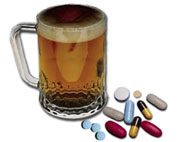|
Overview of Substance Abuse Substance abuse can be defined as continued, compulsive use of mind-altering substances despite personal, social, and/or physical problems, that ultimately can result in dependance to substance used. (Ford-Martin,1995)The characteristics of abuse include a failure to carry out obligations at home or work, continual use under circumstances that present a hazard (such as driving a car) and legal problems such as arrests. Despite personal problems caused by the effects of the substance on self or others, persistance of use signifies dependance.(Carson-DeWitt,1995). Substance dependence has been defined as a group of behavioral and physiological symptoms that indicate the continuous, compulsive use of a substance in self-administered doses despite the problems related to its use.(Carson-DeWitt,1995). Substance abuse and dependence has no barriers and extends beyond all lines of race, culture, educational, and socioeconomic status,therefore leaving no group untouched by its devastating effects.(Carson-DeWitt,1995). Substance abuse is an enormous public health problem, with wide-ranging effects throughout our society. (Carson-DeWitt,1995). Most Commonly Abused Substances The following was addopted from 1. Alcohol 2. Cocaine-based drugs 3. Opioids (including such prescription pain killers as morphine and Demerol, as well as illegal substances such as heroin) 4. Benzodiazapines (including prescription drugs used for treating anxiety, such as valium) 5. Sedatives (including prescription barbiturate drugs commonly referred to as tranquilizers) 6. Stimulants or "speed" (including prescription amphetamine drugs used as weight loss drugs and in the treatment of attention deficit disorder) 7. Cannabinoid drugs obtained from the hemp plant (including marijuana and hashish). 8. Hallucinogenic or "sychedelic" drugs (including LSD, PCP or angel dust, and other PCP-type drugs) 9. Inhalants (including gaseous drugs used in the medical practice of anesthesia, as well as such common substances as paint thinner, gasoline, and glue) (Ford-Martin,1995). |
|





